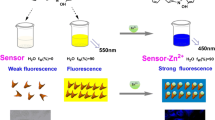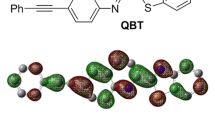Abstract
Fluorescence recognition of Zn2+ in 100 % aqueous medium using 2-((1, 3 dihydroxy-2-(hydroxymethyl)propan-2 ylimino) methyl) phenol (SALTM) as ratiometric probe is reported. Moreover, SALTM can discriminate Zn2+ from Cd2+ very effectively. The binding constant and detection limit of the probe for Zn2+ is 2.2 × 104 M-1/2 and 2.79 × 10−8 M respectively. Interestingly, corresponding naphthalene derivative (HNTM) having less water solubility fails to be a ratiometric sensor. SALTM can detect intracellular Zn2+ in HeLa cervical cancer cells under fluorescence microscope. Moreover, DFT and TD-DFT studies support experimental findings.



























Similar content being viewed by others
References
Frederickson CJ, Koh JY, Bush AI (2005) The neurobiology of zinc in health and disease. Nat Rev Neurosci 6:449–462
Que EL, Domaille DW, Chang CJ (2008) Metals in neurobiology: probing their chemistry and biology with molecular imaging. Chem Rev 108:1517–1549
Lippard SJ, Berg JM (1994) Principles of bioinorganic chemistry. University Science, Mill Valley
Berg JM, Shi Y (1996) Galvanization of biology: a growing appreciation for the roles of zinc. Science 271:1081–1085
Auld DS (2001) Zinc coordination sphere in biochemical zinc sites. Biol Met 14:271–313
Wu ZK, Zhang YF, Ma JS, Yang GQ (2006) Ratiometric Zn2+ sensor and strategy for Hg2+ selective recognition by central metal ion replacement. Inorg Chem 45:3140–3142
Assaf SY, Chung SH (1984) Release of endogenous Zn2+ from brain tissue during activity. Nature 308:734–736
Howell GA, Welch MG, Frederickson CJ (1984) Stimulation-induced uptake and release of zinc in hippocampalslices. Nature 308:736–738
O’Halloran TV (1993) Transition metals in control of gene expression. Science 261:715–725
Koh JY, Suh SW, Gwag BJ, He YY, Hsu CY, Choi DW (1996) The role of zinc in selective neuronal death after transient global cerebral ischemia. Science 272:1013–1016
Suh SW, Jensen KB, Jensen MS, Silva DS, Kesslak PJ, Danscher G, Frederickson CJ (2000) Histochemically-reactive zinc in amyloid plaques, angiopathy, and degenerating neurons of Alzheimer’s diseased brains. Brain Res 2000(852):274–278
Frederickson CJ, Bush AI (2003) Synaptically released zinc: physiological functions and pathological effects. BioMetals 14:353–366
Qian WJ, Gee KR, Kennedy RT (2003) Imaging of Zn2+ release from pancreatic beta-cells at the level of single exocytotic events. Anal Chem 75:3468–3475
Tomat E, Lippard SJ (2010) Imaging mobile zinc in biology. Curr Opin Chem Biol 14:225–230
Lim NC, Freake HC, Brückner C (2005) Illuminating zinc in biological systems. Chem Eur J 11:38–49
Dai Z, Canary JW (2007) Tailoring tripodal ligands for zinc sensing. New J Chem 31:1708
Xu Z, Yoon J, Spring DR (1996) Fluorescent chemosensors for Zn 2+. Chem Soc Rev 39:1996–2006
Lee HG, Lee JH, Jang SP, Park HM, Kim S, Kim Y, Kim C, Harrison RG (2011) Tetrahedron 67:8073
Sturgeon RE, Berman SS, Desaulniers A, Russell DS (1979) Determination of iron, manganese, and zinc in seawater by graphite furnace atomic absorption spectrometry. Anal Chem 51:2364–2369
Tang B, Huang H, Xu K, Tong L, Yang G, Liu X, An L (2006) Highly sensitive and selective near-infrared fluorescent probe for zinc and its application to macrophage cells. Chem Commun 34:3609–3611
Atilgan S, Ozdemir T, Akkaya EU (2008) A sensitive and selective ratiometric near IR fluorescent probe for zinc ions based on the distyryl − bodipy fluorophore. Org Lett 10:4065–4067
Han ZX, Zhang XB, Li Z, Gong YJ, Wu XY, Jin Z, He CM, Jian LX, Zhang J, Shen GL, Yu RQ (2010) Efficient fluorescence resonance energy transfer-based ratiometric fluorescent cellular imaging probe for Zn2+ using a rhodaminespirolactam as a trigger. Anal Chem 82:3108–3113
Xu Y, Pang Y (2010) Zinc binding-induced near-IR emission from excited-state intramolecular proton transfer of abis(benzoxazole) derivative. Chem Commun 46:4070–4072
Zhu J, Yuan H, Chan W, Lee AWM (2010) A colorimetric and fluorescent turn-on chemosensor operative in aqueous media for Zn2+ based on a multi-functionalized spirobenzopyran derivative. Org Biomol Chem 8:3957–3964
Zhang Y, Guo XF, Si WX, Jia JH, Qian XH (2008) Ratiometric and water-soluble fluorescent zinc sensor of carboxamidoquinoline with an alkoxyethylamino chain as receptor. Org Lett 2008(10):473–476
Ajayaghosh A, Carol P, Sreejith S (2005) A ratiometric fluorescence probe for selective visual sensing of Zn2+. J Am Chem Soc 127:14962–14963
Akkaya EU, Huston ME, Czarnik AW (1990) Chelation-enhanced fluorescence of anthrylazamacrocycle conjugate probes in aqueous solution. J Am Chem Soc 112:3590–3593
Burdette SC, Frederickson CJ, Bu W, Lippard SJ (2003) ZP4, an improved neuronal Zn2+ sensor of the Zinpyr family. J Am Chem Soc 125:1778–1787
Ding Y, Xie Y, Li X, Hill JP, Zhang W, Zhu W (2011) Selective and sensitive “turn-on” fluorescent Zn2+ sensors based on di- and tripyrrins with readily modulated emission wavelengths. Chem Commun 47:5431–5433
Maity D, Govindaraju T (2012) A differentially selective sensor with fluorescence turn-on response to Zn2+ and dual-mode ratiometric response to Al3+ in aqueous media. Chem Commun 48:1039–1041
Xu Z, Liu X, Pan J, Spring DR (2012) Coumarin-derived transformable fluorescent sensor for Zn2+. Chem Commun 48:4764–4766
Jiang J, Jiang H, Tang X, Yang L, Dou W, Liu W, Fang R, Liu W (2011) An efficient sensor for Zn2+ and Cu2+ based on different binding modes. Dalton Trans 40:6367–6370
Xu Z, Yoon J, Spring DR (2010) Fluorescent chemosensors for Zn2+. Chem Soc Rev 39:1996–2006
Xu Y, Meng J, Meng L, Dong Y, Cheng Y, Zhu C (2010) A highly selective fluorescence-based polymer sensor incorporating an (R,R)-salen moiety for Zn2+ detection. Chem Eur J 16:12898
Liu X, Zhang N, Zhou J, Chang T, Fang C, Shangguan D (2013) A turn-on fluorescent sensor for zinc and cadmium ions based on perylene tetracarboxylic diimide. Analyst 138:901–906
Mikata Y, Yamashita A, Kawata K, Konno H, Itami S, Yasuda K, Tamotsu S (2012) Hydrogen liberation from the hydrolytic dehydrogenation of dimethylamine–borane at room temperature by using a novel ruthenium nano-catalyst. Dalton Trans 41:4976–4984
Parkesh R, Lee TC, Gunnlaugsson T (2007) Highly selective 4-amino-1,8-naphthalimide based fluorescent photo-induced electron transfer(PET) chemosensors for Zn(II) under physiological pH conditions. Org Biomol Chem 5:310–317
Wang L, Qin W, Liu W (2010) Synthesis, characterization and crystal structure of a new fluorescent probe based on Schiff Base for the detection of Zinc (II). Inorg Chem Commun 13:1122
Udhayakumari D, Saravanamoorthy S, Ashok M, Velmathi S (2011) Simple imine linked colorimetric and fluorescent receptor for sensing Zn2+ ions in aqueous medium based on inhibition of ESIPT mechanism. Tetrahedron Lett 52:4631–4635
Dong Y, Li J, Jiang X, Song F, Cheng Y, Zhu C (2011) Na+ triggered fluorescence sensors for Mg2+ detection based on a coumarin salen moiety. Org Lett 13:2252–2255
Cozzi PG (2004) Metal–Salen Schiff base complexes in catalysis: practical aspects. Chem Soc Rev 33:410–421
Pucci D, Aiello I, Bellusci A, Crispini A, Ghedini M, Deda ML (2009) Coordination induction of nonlinear molecular shape in mesomorphic and luminescent ZnII complexes based on salen-like frameworks. Eur J Inorg Chem 28:4274–4281
Niu LY, Guan YS, Chen YZ, Wu LZ, Tung CH, Yang QZ (2012) BODIPY-based ratiometric fluorescent sensor for highly selective detection of glutathione over cysteine and homocysteine. J Am Chem Soc 134:18928–18931
Das P, Mandal AK, Chandar AB, Baidya M, Bhatt HB, Ganguly B, Ghosh SK, Das A (2012) New chemo-dosimetric reagents as ratiometric probes for cysteine and homocysteine and possible detection in living cells and in blood plasma. Chem Eur J 18:15382–15393
Lin HY, Cheng PY, Wan CF, Wu AT (2012) A turn-on and reversible fluorescence sensor for zinc ion. Analyst 137:4415–4417
Ashton TD, Jolliffe KA, Pfeffer FM (2015) Luminescent probes for the bioimaging of small anionic species in vitro and in vivo. Chem Soc Rev 44:4547–4595
Woo H, You Y, Kim T, Jhon GJ, Nam W (2012) Fluorescence ratiometric zinc sensors based on controlled energy transfer. J Mater Chem 22:17100–17112
Burla MC, Caliandro R, Camalli M, Carrozzini B, Cascarano GL, Caro LD, Giacovazzo C, Polidori G, Spagna R (2005) SIR 2004: an improved tool for crystal structure determination and refinement. J Appl Crystallogr 38:381–388
Sheldrick GM (2008) A short history of SHELX. Acta Crystallogr Sect A 64:112–122
Banerjee A, Sahana A, Lohar S, Sarkar B, Mukhopadhyay SK, Das D (2013) A FRET operated sensor for intracellular pH mapping: strategically improved efficiency on moving from an anthracene to a naphthalene derivative. RSC Adv 3:14397–14405
Austin E, Gouterman M (1978) Absorption and emission of weak complexes with acids, bases, and salts. Bioinorg Chem 9:281–298
Melhuish WH (1961) Quantum efficiencies of fluorescence of organic substances: effect of solvent and concentration of the fluorescent solute. J Phys Chem 65:229–235
Reja SI, Bhalla V, Sharma A, Kaur G, Kumar M (2014) A highly selective fluorescent probe for hypochlorite and its endogenous imaging in living cells. Chem Commun 50:11911–11914
Benesi HA, Hildebrand JH (1949) A spectrophotometric investigation of the interaction of iodine with aromatic hydrocarbons. J Am Chem Soc 71:2703–2707
Acknowledgments
B. Kumari and S. Lohar are thankful to BU and CSIR for fellowship. Assistance from CAS (UGC) is gratefully acknowledged.
Author information
Authors and Affiliations
Corresponding author
Additional information
CCDC numbers of SALTM and HNTM are 992217 and 993440 respectively.
Rights and permissions
About this article
Cite this article
Kumari, B., Lohar, S., Ghosh, M. et al. Structurally Characterized Zn2+ Selective Ratiometric Fluorescence Probe in 100 % Water for HeLa Cell Imaging: Experimental and Computational Studies. J Fluoresc 26, 87–103 (2016). https://doi.org/10.1007/s10895-015-1688-9
Received:
Accepted:
Published:
Issue Date:
DOI: https://doi.org/10.1007/s10895-015-1688-9




